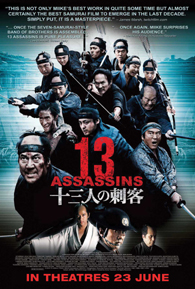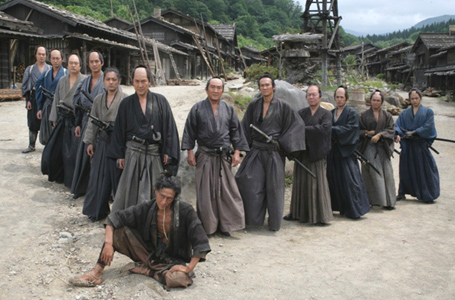
Perhaps the answer to the Spaghetti Western in terms of the Japanese period piece are a series of films known as the “zankoku jidaigeki” (“cruel period piece”), from hereon to be referred to simply as zankoku. In a rapid departure from the more lavish, nostalgic traditional period pieces with their colourful, Ukiyo-e inspired compositions and traditional stories of honour and heroism, these were often stark black and white films. The transitional piece for this subgenre is probably the great Akira Kurosawa’s Yojimbo, which featured the now-classic tale of a wandering samurai who exploits human greed to destroy two warring clans of yakuza, and set the tone for the future zankoku to come. Other featured themes include the problems of institutional evil (Seppuku, Bushido), cosmic amorality (The Sword of Doom) and moral cowardice (Samurai Rebellion). Despite their heavy themes, they have aged well and still are some of the most memorable, powerful and entertaining films ever made.
Such heavy films would seem like foreign territory for the punk rock sensibilities of Japanese cinematic bad boy Takashi Miike, a man who has built his cult career on giddy, eccentric exploitation films. But even bad boys want respectability, and Miike no less. What better way than in taking on the old masters and hopefully trying to surpass them? 13 Assassins is Miike’s attempt at doing so, and try he does. The film is itself a remake a well-regarded 1963 classic zankoku directed by Eiichi Kudo, but adding a few of his own irreverent trademarks, Miike attempts here to do nothing short of recreating the cruel classics for a new generation.
And cruel is as cruel does. The year is 1844, a mere decade before the Black Ships of Commodore Perry will open Japan to globalisation. The Shogun’s babyfaced younger brother, Lord Naritsugu, is deservingly reviled for his inhuman cruelty towards his subjects. Psychopathic to the point of grotesquerie, his list of misdeeds include rape, mutilation, and murder. Yet inexplicably, he is soon to be promoted to the list of Shogun’s advisors. The noble Sir Doi seeks to prevent Japan from falling into a dark age of tyranny and enlists the help of Shimada Shinzaemon, a Royal Metsuke (something akin to an Edo-era intelligence chief.) to assemble a group of fellow samurai to assassinate Naritsugu on his way from Tokyo. They assemble twelve good swordsmen, and are joined by a 13th, a rowdy roughneck peasant hunter (Yusuke Iseya) named Koyata, who seems to be a nod to Mifune’s lovable rowdy peasant Kikuchiyo from Seven Samurai. Before long, in one long epic battle taking up about a third of the film’s running time, these thirteen men will face Naritsugu’s entourage of over 200, led by Shinzaemon’s old friend Hanbei, a good man bound by his code to protect his evil boss, yet fully aware of the nature of the man he serves.
Considering the dire financial straits of the Japanese film industry and the relative unpopularity of historical dramas in recent years, Miike’s relatively big-budget epic is a rare piece of serious showmanship. It avoids adopting an overly manga sensibility the way recent films like Kamui and Goemon did: everyone is authentically cast and dressed with respect to the period depicted with no attempts to “prettify” everyone for modern sensibilities, right down to the depictions of aristocratic women with blackened teeth. Framing and composition are done in the manner of the old masters in the first half, as well as attempts to capture the same stately yet intense pacing they possessed. The melee battle sequence when it arrives though, obviously attempts to ape Kurosawa’s Seven Samurai as well as the original, and throws in some of Miike’s anarchic humour for good measure.
The final result is entertaining as hell, but I found myself asking, as did Peggy Lee, “Is that all there is?” The truth is really that when you attempt to ape the masters all the time, you forget to develop a style of your own more fully. It doesn’t help either when Miike’s story at the end of the day, is face it, pretty thin and underwhelming. Naritsugu is such a complete monster, and not a very bright one at that, he’s at the end of the day terribly uninteresting. Most of the thirteen heroes have barely articulated personalities to the extent you wonder what stakes there are even when they die, and many of Miike’s personal touches seem to confuse being clever with being good. Even the much-vaunted melee battle sequence feels at times like something out of a video game: bulls on fire, dynamite explosions, barricades that seem to pop out of nowhere. The combat while gory fun, lacks the clear, precise evocation of space and movement of its predecessors. The conflicts, while well-written and resolved, are pretty much standard for the genre as it is, with few surprises.
13 Assassins is one of those movies that leaves you hanging. You want more, but sense that Miike tries to ape the masters with mixed results in this revival of the “cruel period piece”, that he’d be better if he was making his own movie.

